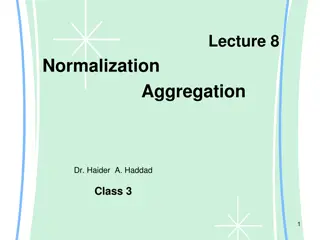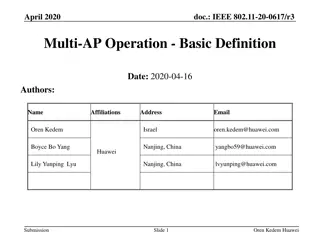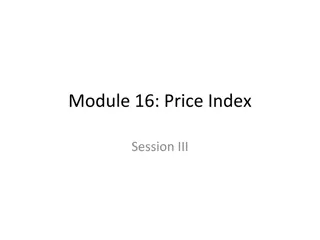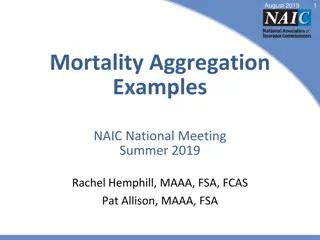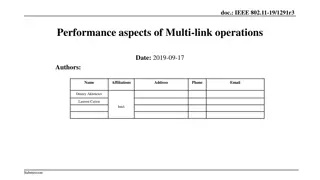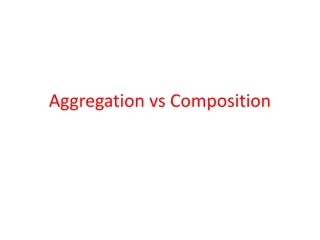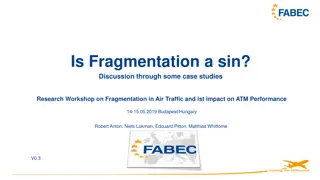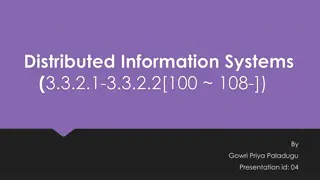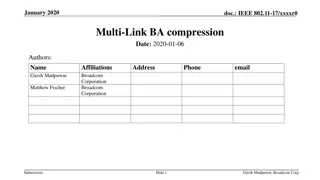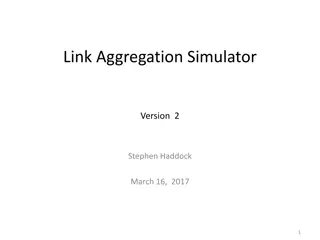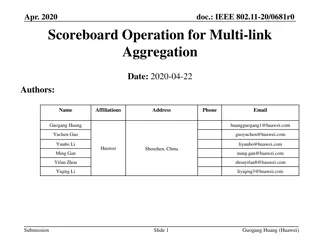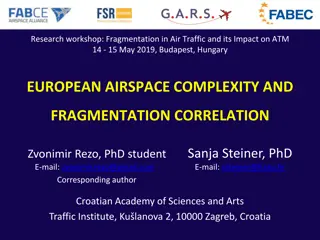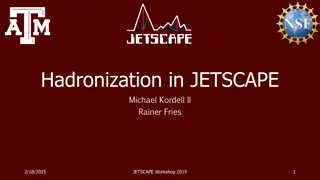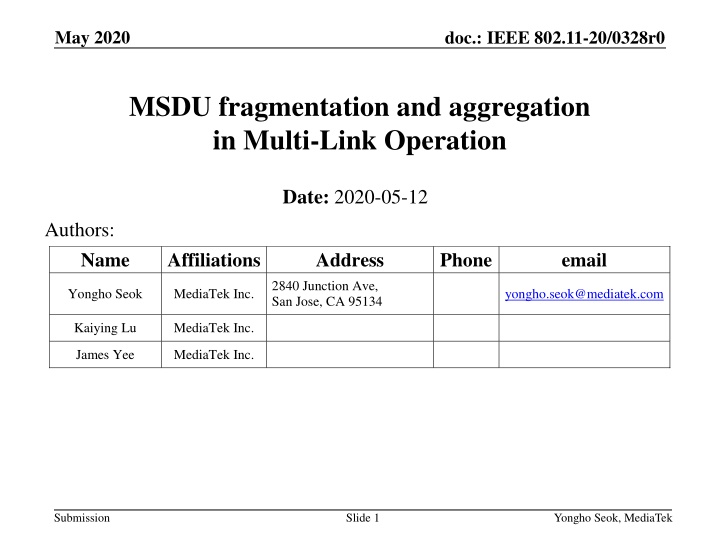
IEEE 802.11-20: MSDU Fragmentation and Aggregation in Multi-Link Operation
In this document dated May 2020, the topic of MSDU fragmentation and A-MSDU aggregation in Multi-Link Operation is addressed, discussing issues related to recipient STA determination, handling of fragmentation and aggregation, and implications of retransmissions to different peer STAs.
Download Presentation

Please find below an Image/Link to download the presentation.
The content on the website is provided AS IS for your information and personal use only. It may not be sold, licensed, or shared on other websites without obtaining consent from the author. If you encounter any issues during the download, it is possible that the publisher has removed the file from their server.
You are allowed to download the files provided on this website for personal or commercial use, subject to the condition that they are used lawfully. All files are the property of their respective owners.
The content on the website is provided AS IS for your information and personal use only. It may not be sold, licensed, or shared on other websites without obtaining consent from the author.
E N D
Presentation Transcript
May 2020 doc.: IEEE 802.11-20/0328r0 MSDU fragmentation and aggregation in Multi-Link Operation Date: 2020-05-12 Authors: Name Affiliations Address Phone email 2840 Junction Ave, San Jose, CA 95134 Yongho Seok MediaTek Inc. yongho.seok@mediatek.com Kaiying Lu MediaTek Inc. James Yee MediaTek Inc. Submission Slide 1 Yongho Seok, MediaTek
May 2020 doc.: IEEE 802.11-20/0328r0 Motivation The supported maximum MPDU length, the supported maximum number of MSDUs in A-MSDU, and other capabilities of each STA of a MLD can be different. Submission Slide 2 Yongho Seok, MediaTek
May 2020 doc.: IEEE 802.11-20/0328r0 Motivation The MSDU fragmentation or the A-MSDU aggregation is constrained by the supported maximum MPDU length, the supported maximum number of MSDUs in A-MSDU, and other capabilities of the recipient STA. But, in the Multi-Link Operation (MLO), an issue is that the recipient STA is not determined until obtaining the TXOP and it can be also changed as a frame is retransmitted in different link. This contribution discusses how to handle the MSDU fragmentation and the A-MSDU aggregation in the MLO. Submission Slide 3 Yongho Seok, MediaTek
May 2020 doc.: IEEE 802.11-20/0328r0 MSDU fragmentation and A-MSDU aggregation in MLO The MSDU fragmentation and the A-MSDU aggregation can be decided after a STA in the Multi- Link Device (MLD) obtains the TXOP. In such case, the maximum MPDU length, the maximum number of MSDUs in A-MSDU, and other capabilities of the peer STA on the same link limits the MSDU fragmentation and the A-MSDU aggregation. Submission Slide 4 Yongho Seok, MediaTek
May 2020 doc.: IEEE 802.11-20/0328r0 MSDU fragmentation and A-MSDU aggregation in MLO However, when a frame is retransmitted to a different peer STA that does not support the maximum MPDU length, the maximum number of MSDUs in A-MSDU, and other capabilities supposed in the initial frame transmission, the MSDU fragmentation and the A- MSDU aggregation should be performed again. It can cause a significant implementation complexity. Submission Slide 5 Yongho Seok, MediaTek
May 2020 doc.: IEEE 802.11-20/0328r0 MSDU fragmentation and A-MSDU aggregation in MLO Otherwise, a frame can be retransmitted only to the peer STAs that support the maximum MPDU length, the maximum number of MSDUs in A-MSDU, and other capabilities supposed in the initial frame transmission. It is a simple solution but the performance of the MLO can be reduced. Submission Slide 6 Yongho Seok, MediaTek
May 2020 doc.: IEEE 802.11-20/0328r0 MSDU fragmentation and A-MSDU aggregation in MLO Depending on the MAC architecture, performing the MSDU fragmentation and the A-MSDU aggregation after obtaining a TXOP may not be applicable. In such case, the MLO can define common capabilities among all enabled links for the MSDU fragmentation and A-MSDU aggregation. Those common capabilities can defined in an explicit exchange, or an implicit manner like the below: The minimum of the Maximum MPDU Length field values of all enabled links is used. The minimum of the Max Number Of MSDUs In A-MSDU field values of all enabled links is used. Submission Slide 7 Yongho Seok, MediaTek
May 2020 doc.: IEEE 802.11-20/0328r0 Fragment transmission in MLO Fragments of single MSDU in the MLO can be sent through each different links. In such case, the recipient MLD may need additional logic (e.g., common buffer) to reassemble the fragmented MSDUs which are received from each different links. Considering more flexible design architecture, the recipient MLD should indicate whether the fragments of single MSDU can be sent through each different links. Submission Slide 8 Yongho Seok, MediaTek
May 2020 doc.: IEEE 802.11-20/0328r0 Fragment transmission in MLO When the recipient MLD supports that the fragments of single MSDU are sent through each different links, the simultaneous transmission on the multiple links should be also possible. Because the recipient MLD delivers the MSDU to an upper layer after completely reassembling all fragmented MSDUs. Link 2 Data [TID1, Seq1, Frag1] ACK Link 1 ACK Data [TID1, Seq1, Frag0] Submission Slide 9 Yongho Seok, MediaTek
May 2020 doc.: IEEE 802.11-20/0328r0 Conclusion When STAs within a MLD have each different MAC parameters, some MAC operations like the MSDU fragmentation and the A-MSDU aggregation may need some architecture changes. In order to minimize the implementation complexity, applying common capabilities among all enabled links for the MSDU fragmentation and A-MSDU aggregation is preferred. Submission Slide 10 Yongho Seok, MediaTek
May 2020 doc.: IEEE 802.11-20/0328r0 Straw Poll 1 Do you support that each STA in a MLD has common capabilities for the maximum MPDU length and the maximum number of MSDUs in an A-MSDU, and the maximum A-MSDU length? These capabilities are carried in the EHT capabilities element Submission Slide 11 Yongho Seok, MediaTek
May 2020 doc.: IEEE 802.11-20/0328r0 Straw Poll 2 Do you support that when a transmitter MLD fragments a single MSDU, it shall send all fragments on the same link unless the receiver MLD indicates whether the fragments of single MSDU can be sent through each different links. In which case, the transmitter MLD may send the fragments through each different links? Submission Slide 12 Yongho Seok, MediaTek

